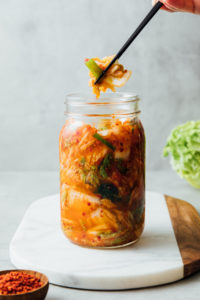VEGAN KIMCHI
This easy Vegan Kimchi recipe is 100% whole food plant based and full of spicy, tangy flavor! It’s a natural probiotic for a healthy and delicious condiment!
- Prep Time: 36 - 48 hours
- Total Time: 0 hours
- Yield: Makes 3 - 4 cups
- Category: Side, Condiment
- Method: ferment
- Cuisine: Korean, Asian
- Diet: Vegan
Ingredients
- 1 medium Napa cabbage, about 2 lbs (savoy, green or any combo works too)
- 1/4 cup kosher salt (non-iodized sea salt or other coarse salt is great too)
- 6 cups water
- 3/4 sweet apple (I used fuji), chopped
- 1/2 small white onion, chopped
- 1 1/2 inch ginger, chopped
- 1 - 2 cloves garlic
- 3 tablespoons gochugaru (Korean red chili powder) or 1 tablespoon each cayenne & Hungarian paprika
- 3 - 4 scallions (green onions), sliced 1 inch
Instructions
Preparing Cabbage: Quarter cabbage and chop laterally into about 2 inch pieces. Place cabbage in an extra large bowl or pot. Combine salt with 2 cups of lukewarm water, stir to dissolve salt. Pour salt water over the cabbage and add remaining 4 cups, stir to mix. If you can, place a plate or circular baking dish of sorts on top to submerge the cabbage (I used a pie dish), place something with a good amount of weight on top to hold down if necessary (it’s not completely necessary but will help to evenly wilt the cabbage). Give cabbage a good mix every now and then. Let soak for 2 hours, up to 12 if you like. I found that 2 – 4 hours was enough and didn’t see much change between the two times.
Make your seasonings: While cabbage is soaking, combine apple, onion, ginger and garlic in food processor/blender and process until fairly smooth.
In a small bowl, mix the chili pepper with a small amount of water to make a wet paste. You can just as easily blend it with the apple/onion mixture adding a couple tablespoons of water as well.
Mix everything together: Once cabbage is ready, drain water, reserving 1/2 cup, and rinse well. Place cabbage back in large bowl, combine with the scallions, apple/onion mixture and chili paste. Mix well to coat all pieces. Either use your hands (with gloves on pref to protect from the chili pepper) or simply use wooden spoons to toss everything.
Packing: Place the kimchi in glass jars or containers with lid, pack down the best you can to close air pockets and leave about an inch at the top for air and gases. Top with remaining juices, add reserved brine if needed to cover vegetables.
Fermenting: Let kimchi sit at room temp (or in a cool place like a pantry or closet if weather is extremely warm) for 24 – 36 hours. After 24 hours, open kimchi and pack the mixture down with a spoon (the cabbage will have likely shrunk and you’ll have more liquids). You may notice it bubbling, this is perfectly normal as the kimchi is fermenting. As your kimchi ferments the flavors will develop, taste every 24 hours and place kimchi in the refrigerator once you’re happy with the taste and to slow fermentation, usually after 36 – 48 hours. It should be tangy, spicy and slightly sweet. After moving to the fridge, it’s best used within a month, maybe two.
Makes about 3 – 4 cups
Serve with rice, use in Kimchi Fried Rice or make Kimchi Tofu Scramble!
Notes
Practice makes perfect with kimchi. You may find you like it more or less spicy. After a few tries you’ll find the perfect mix to suit your taste. Also, how fermented you like your kimchi will take practice as well. The weather will also play a role in how fast/slow your mixture will ferment. Higher temperatures will progress fermentation while cooler will slow it down.
Apple substitute: If you’re in a pinch without an apple in sight, use 2 teaspoons of organic pure cane sugar, coconut sugar or sugar in the raw, just the purest sugar you can find. You may like to add a bit of water to the mix as well, about 2 – 3 tablespoons.
You can also enjoy kimchi fresh right after you mix it and store it straight in the fridge. You may like to experiment by putting half the recipe in the fridge and the other half in the pantry to ferment & sour to see which flavor is your favorite.
Optional ingredients for color and variation: carrots and/or daikon radish (grated or julienned), about a 1/2 cup of each. If using these, add to cabbage when mixing scallions and wet mixtures together.
If using savoy or green cabbage, quarter cabbage, remove core and roughly slice.
If you don’t have glass jars, plastic containers with lids will work just as well. If you have too much room, more than an inch, place plastic wrap over top, but sinking in close to the surface of the kimchi to remove air, and cover with lid.
Find it online: https://simple-veganista.com/kimchi/
